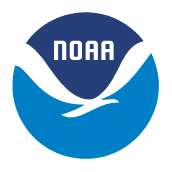Community Forecast Model Adds Fire and Smoke Prediction Capabilities
A new upgrade of the Unified Forecast System’s (UFS) Short-Range Weather (SRW) Application, which was released by the Earth Prediction Innovation Center (EPIC) in April 2025, contains significant contributions from the NOAA Global Systems Laboratory (GSL). The update (Version 3.0) adds new capabilities for modeling wildfire smoke and dust for weather model developers and researchers.

The SRW Application is designed for short-range, regional weather forecasts at time scales from minutes to several days. It includes all of the capabilities needed to run an end-to-end forecast, from defining a model grid to generating graphics. This model release was made possible by a large team of scientists and engineers at multiple NOAA laboratories (led by GSL), the National Center for Atmospheric Research (NCAR), the National Weather Service (NWS), and university cooperative institutes, and was facilitated by the EPIC program at the NOAA Weather Program Office.
A number of contributions were made by GSL’s model development teams:
- GSL’s atmospheric composition team contributed to the implementation of the smoke modeling capability, including leading model development, conducting evaluation tests, and preparing the corresponding documentation. These new capabilities are a major milestone for community-based modeling of smoke and dust aerosols. In addition, this represents an important step in the UFS application’s convergence with the smoke and dust modeling framework of the Rapid Refresh Forecast System (RRFS), a next-generation, experimental model for high-resolution weather and air quality forecasting that is targeted for use in NWS operations in the future.
- GSL developers contributed updates to the Common Community Physics Package (CCPP) implemented in the SRW Application. CCPP is a state-of-the-art framework designed to facilitate community-wide development of atmospheric physics parameterizations, which are used to describe subscale processes such as radiation, thermodynamics, and turbulence. The documentation for these physics parameterizations was organized by the Developmental Testbed Center (DTC) team at GSL and NCAR.
- GSL played a key role in the implementation of the Unified Workflow (UW) Tool, which modernizes the mechanics of the model’s workflow. With the UW Tool now being used in the SRW Application, researchers and developers are able to more efficiently configure its run-time management, allowing for simple “plug-and-play” for different types of model runs.
The UFS is a community-based Earth modeling system with shared science components and software infrastructure. It is designed to be the source system for NOAA’s operational numerical weather prediction applications while enabling research, development, and contribution opportunities for the broader weather enterpriseAs the UFS continues to evolve as a collaborative modeling framework, GSL, along with several other organizations in NOAA, work alongside a wide range of developers in the meteorological community to consistently expand and improve its capabilities. Keep up-to-date on further UFS updates by visiting the EPIC UFS website at https://ufs.epic.noaa.gov/
Contributors to this release:
NOAA Laboratories:
- Global Systems Laboratory (GSL)
- Air Resources Laboratory (ARL)
- Geophysical Fluid Dynamics Laboratory (GFDL)
- National Severe Storms Laboratory (NSSL)
- Physical Sciences Laboratory (PSL)
Other NOAA partners:
- National Centers for Environmental Prediction/Environmental Modeling Center (NCEP/EMC)
- Weather Program Office (WPO)
Cooperative Institutes:
- Cooperative Institute for Research in Environmental Sciences (CIRES)
- Cooperative Institute for Research in the Atmosphere (CIRA)
- Cooperative Institute for Satellite Earth System Studies (CISESS)
- Cooperative Institute for Severe and High-Impact Weather Research and Operations (CIWRO)
External partners:
- National Center for Atmospheric Research’s (NCAR’s) Climate and Global Dynamics (CGD) Laboratory and Research Application Laboratory (RAL)
- Developmental Testbed Center (DTC)
- Earth Prediction Innovation Center (EPIC)
Our Mission
Lead research and directed development through the transition of environmental data, models, products, tools, and services to support commerce, protect life and property, and promote a scientifically literate public.
Research Areas
Organizational Excellence, Earth System Prediction, Advanced Technologies, and Decision Support are the foundation to achieving the GSL Grand Challenge: Deliver actionable global storm-scale prediction and environmental information through advanced technologies to serve society.
Global Systems Laboratory

